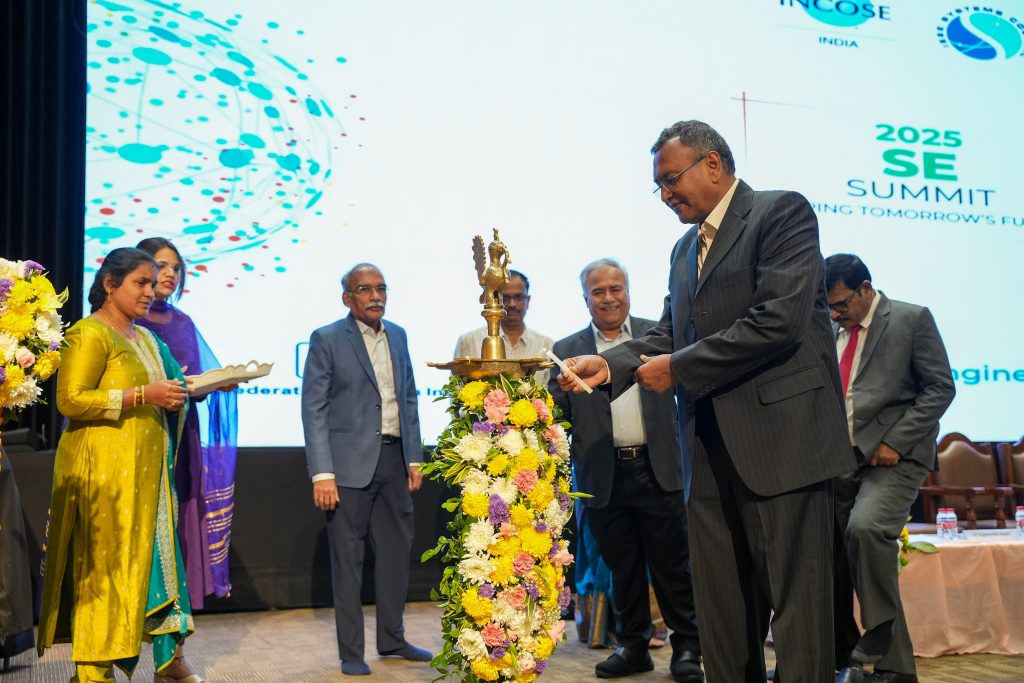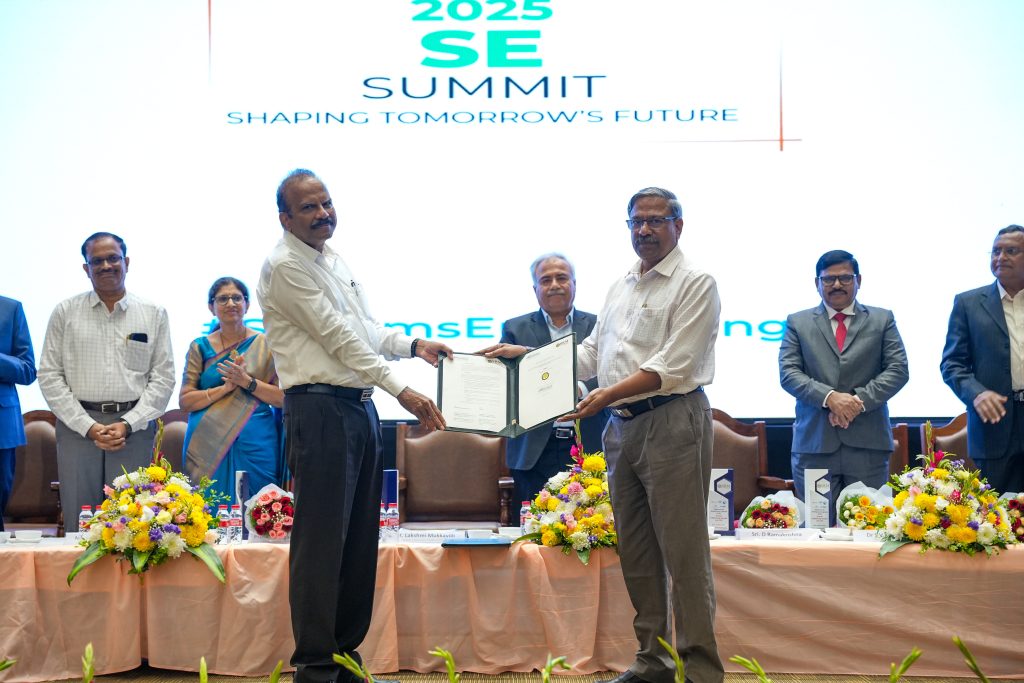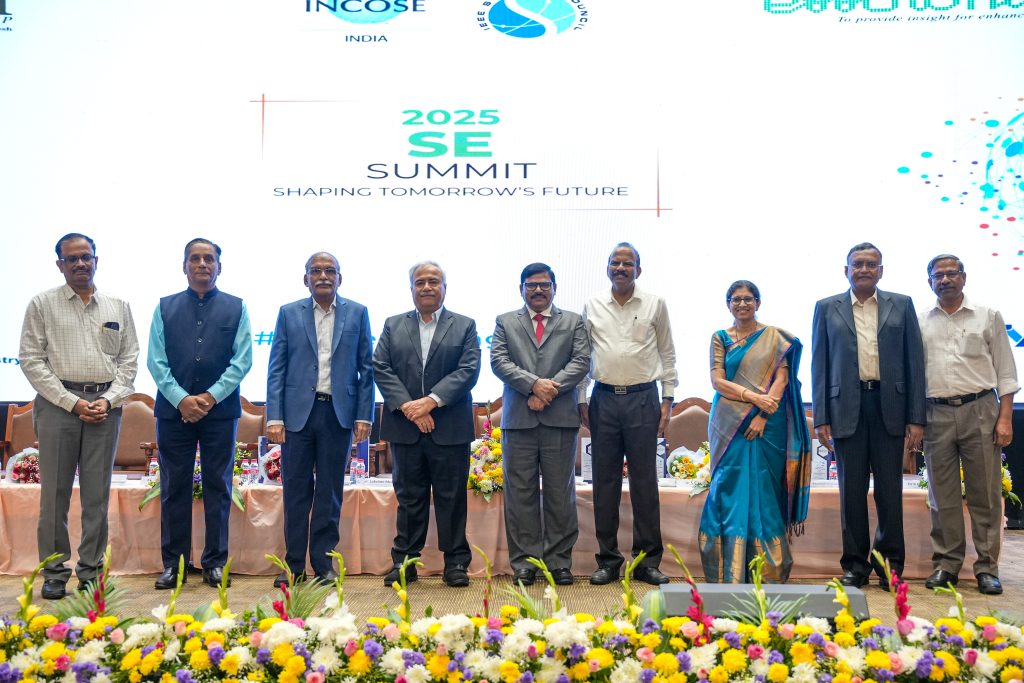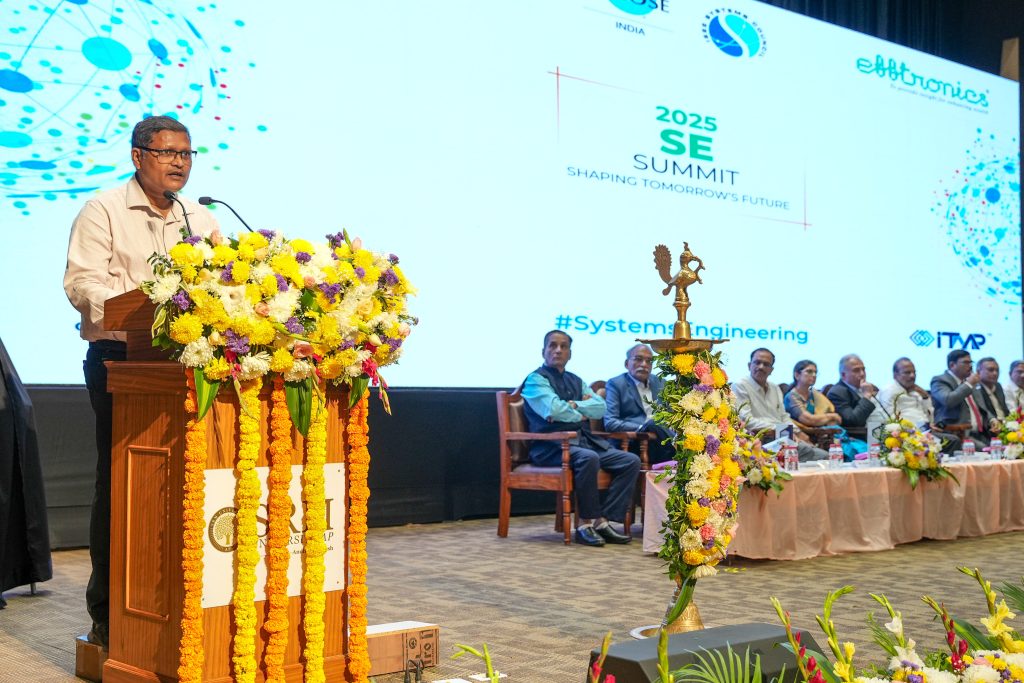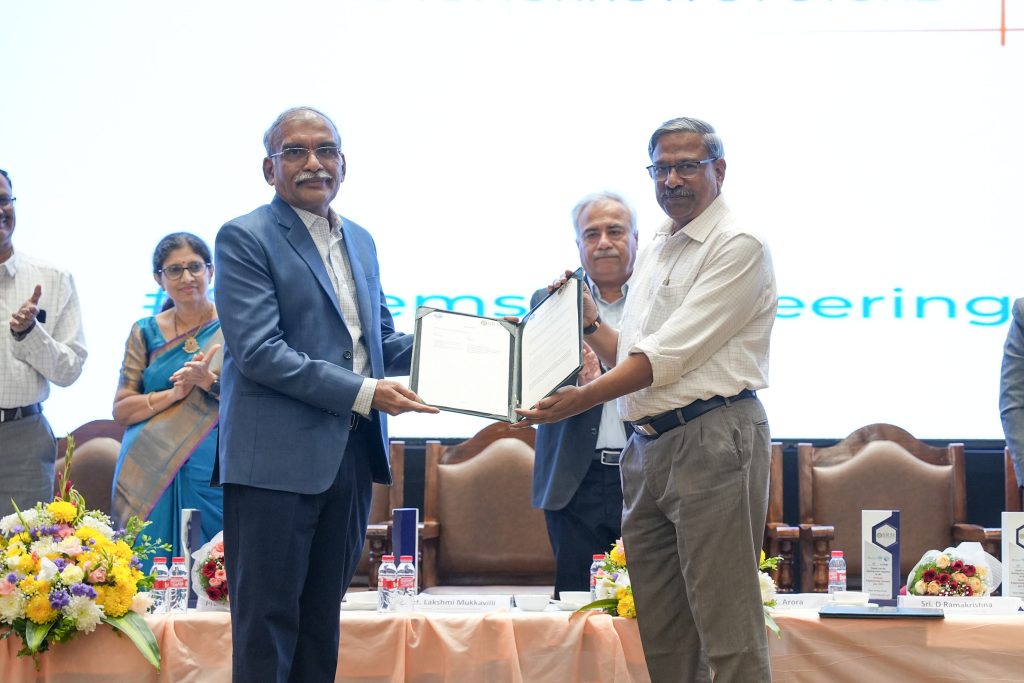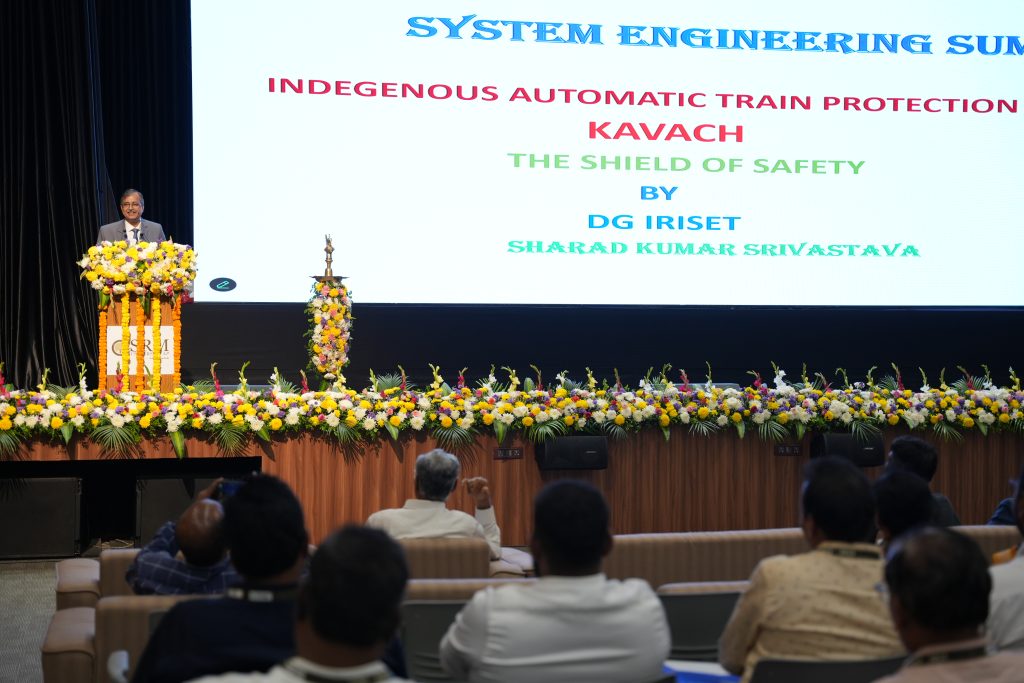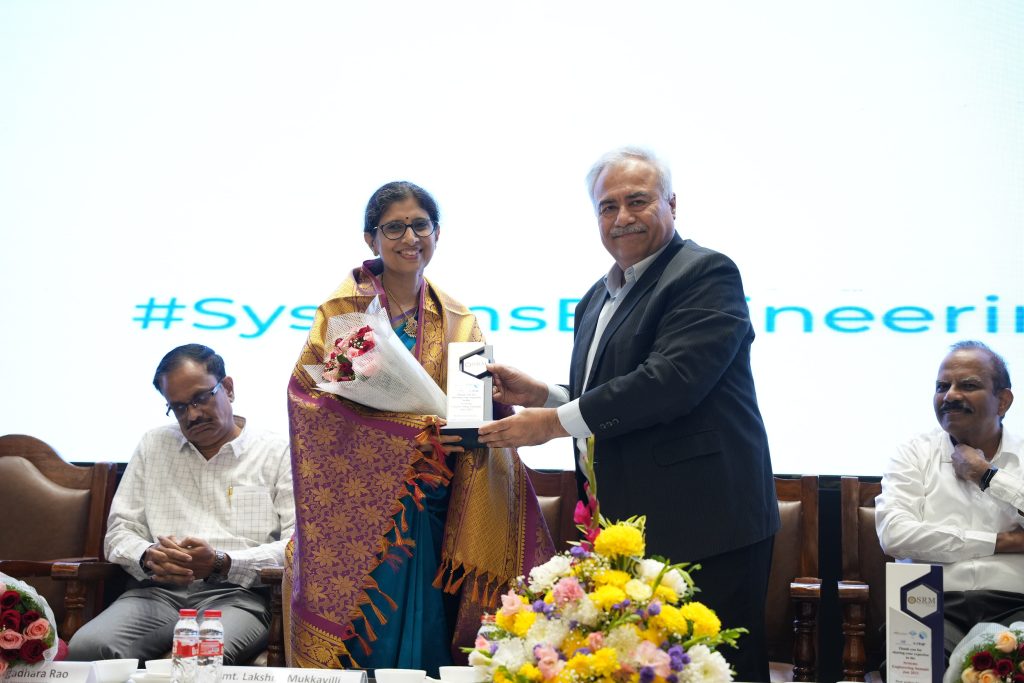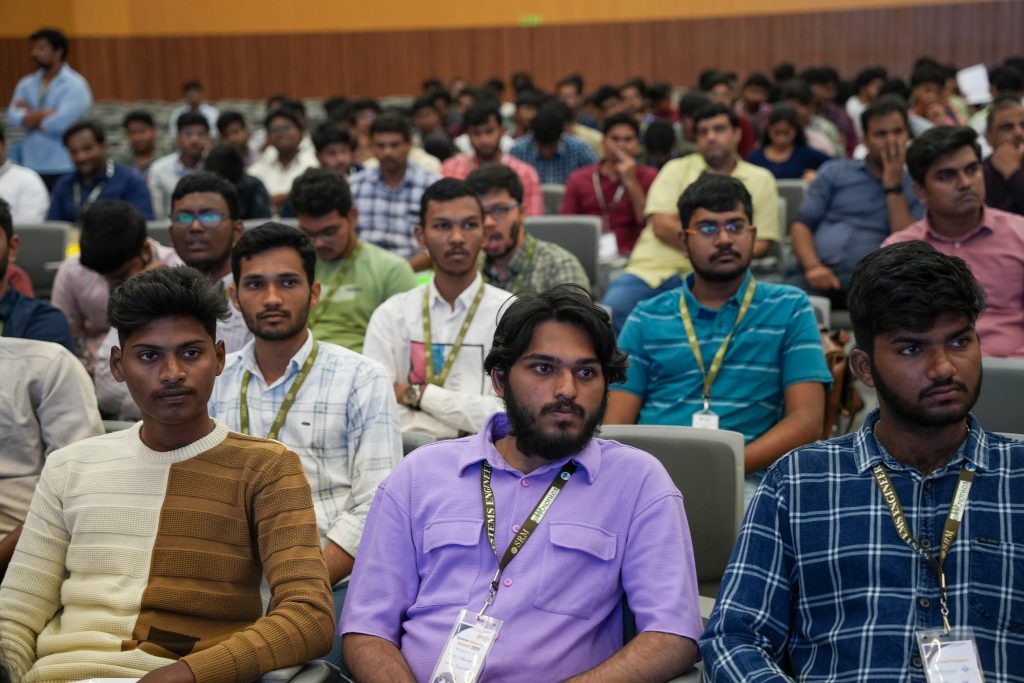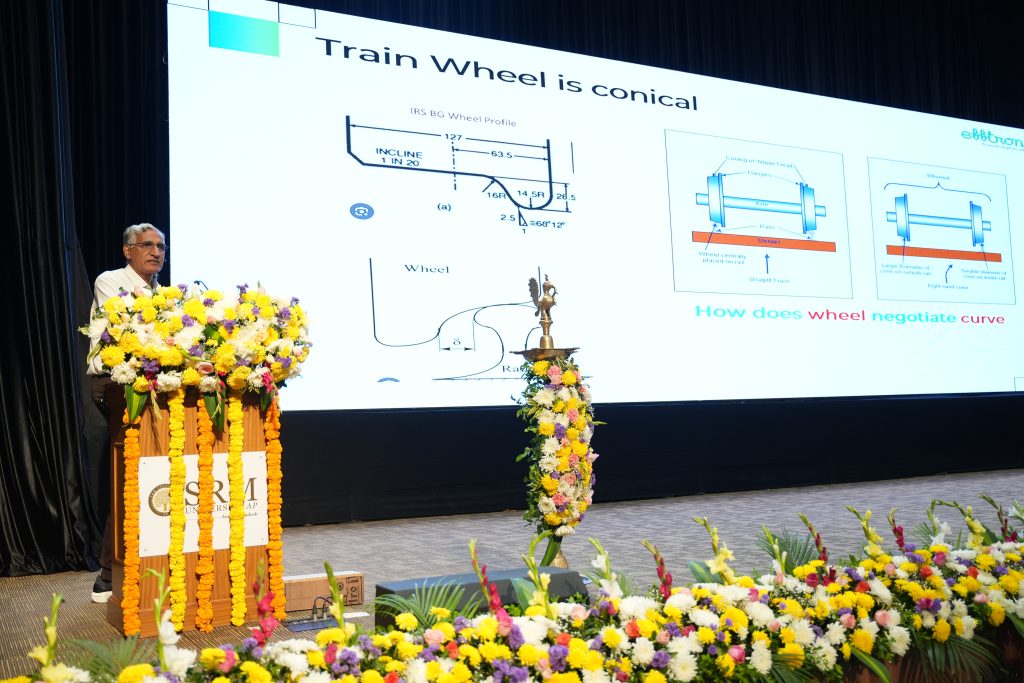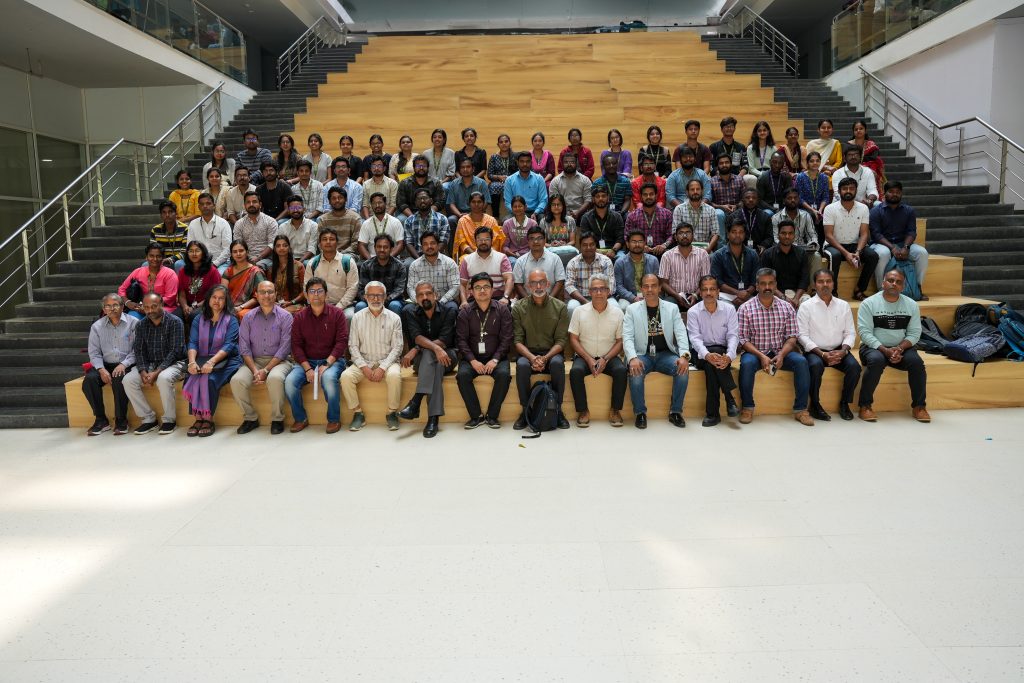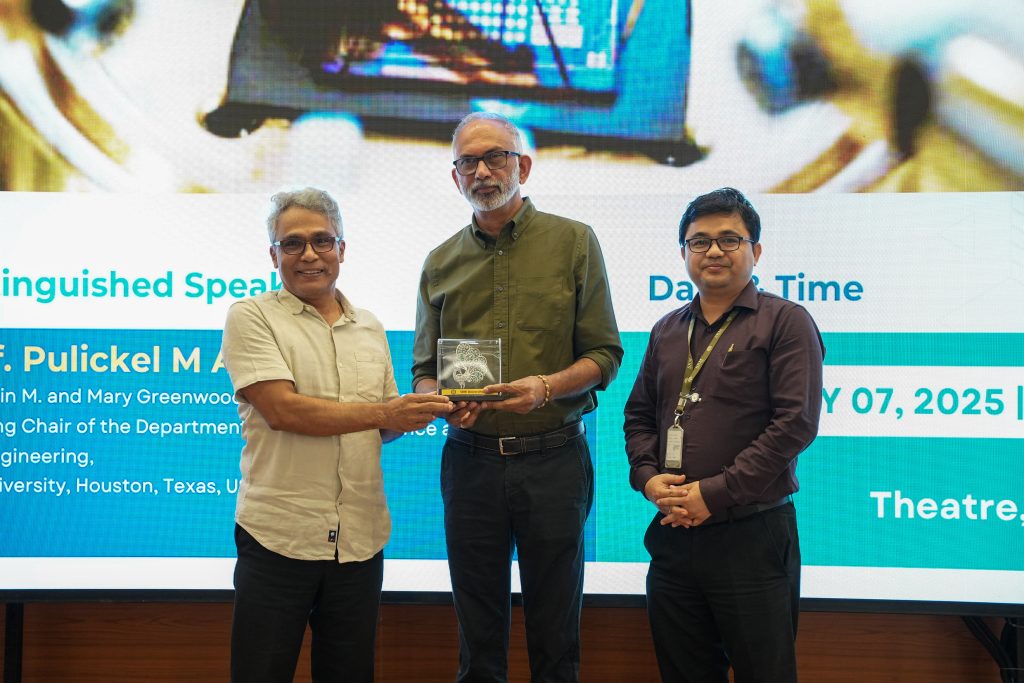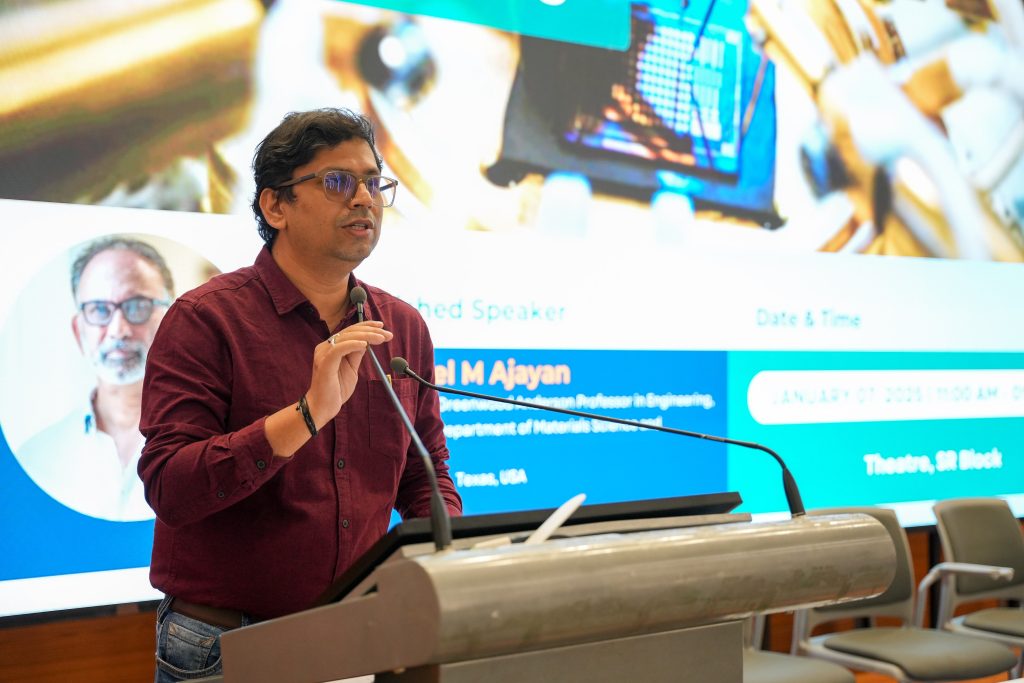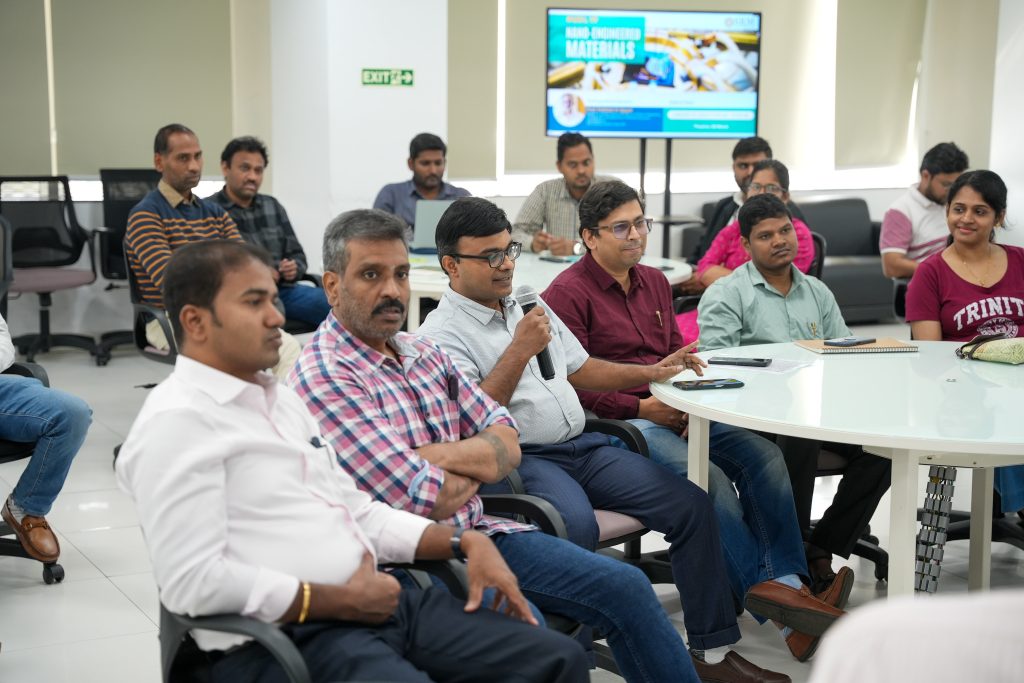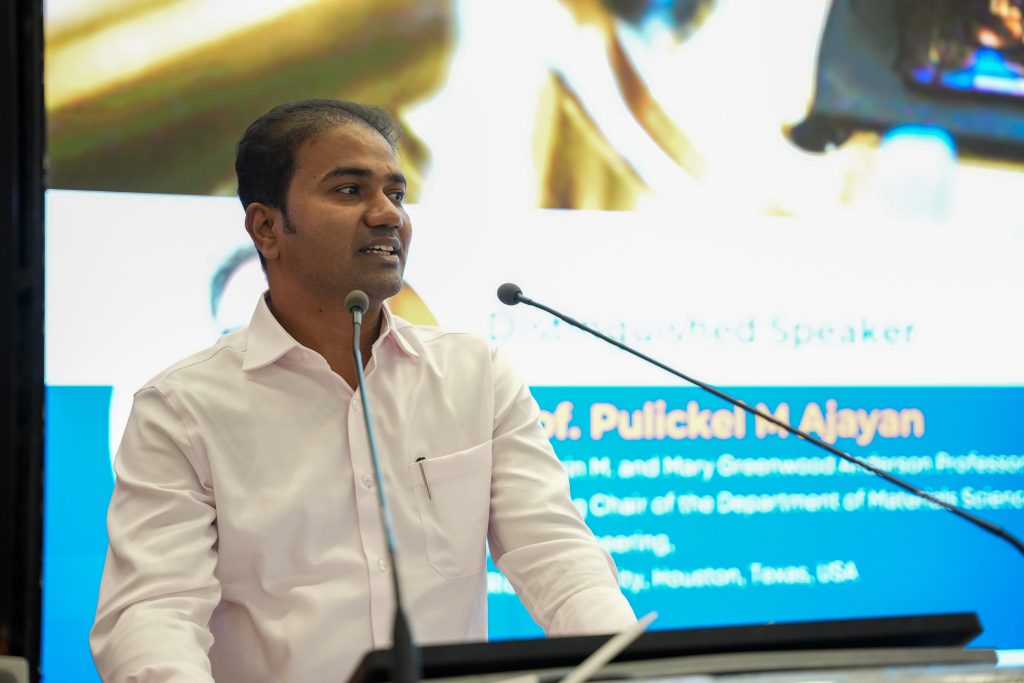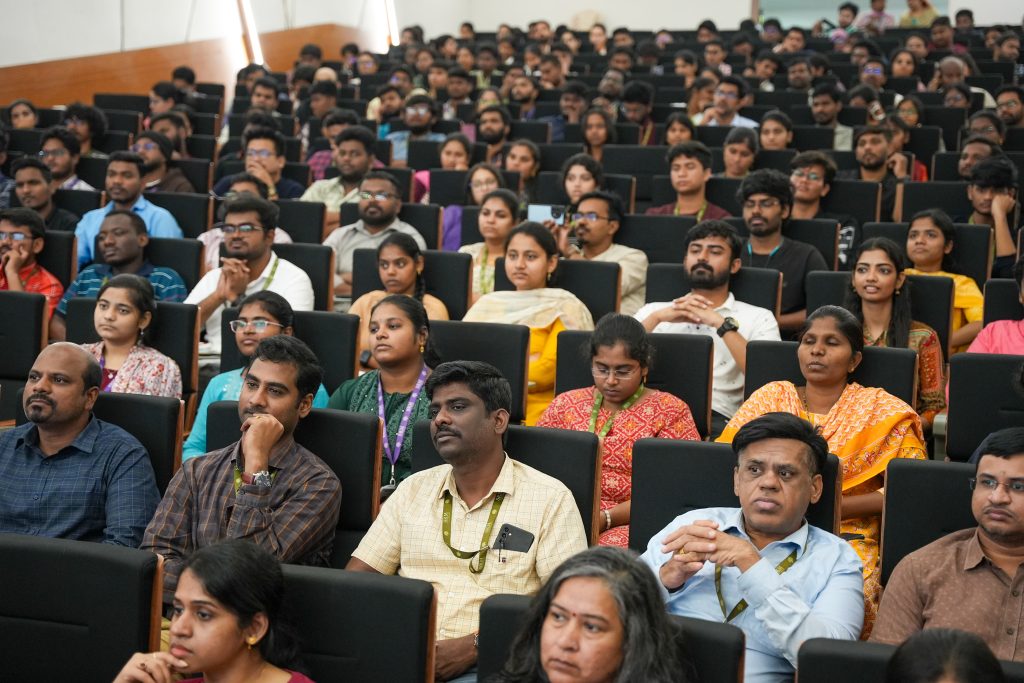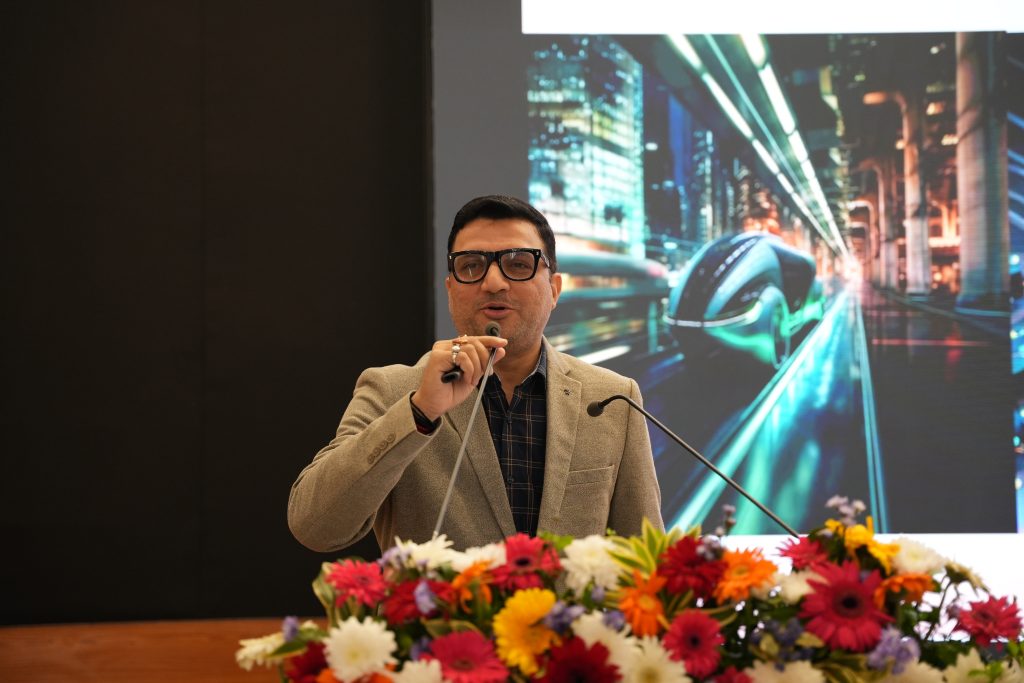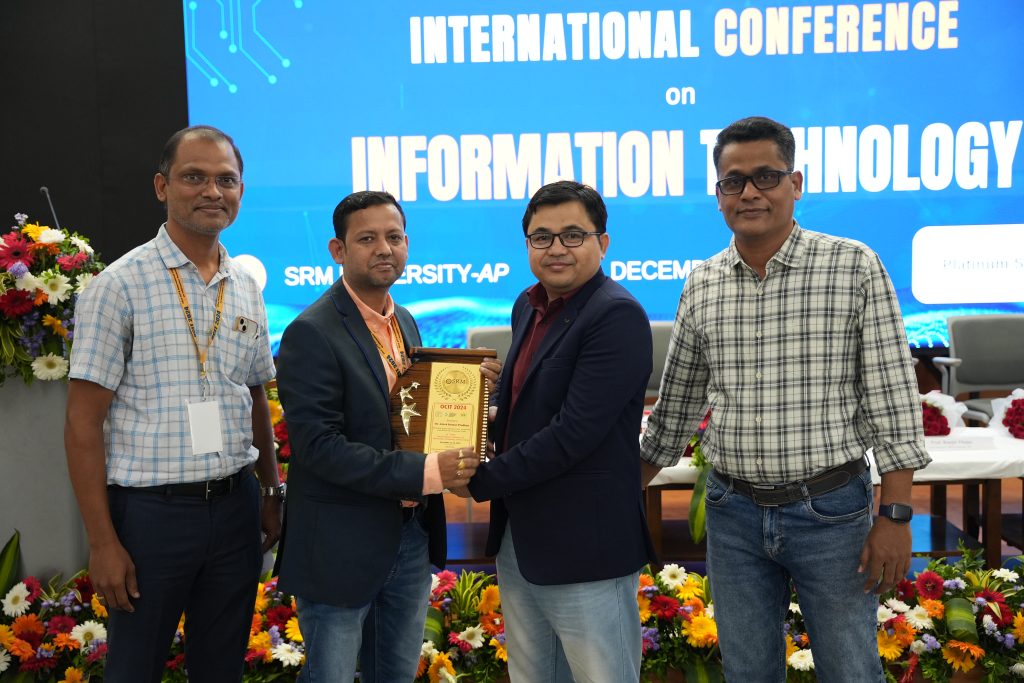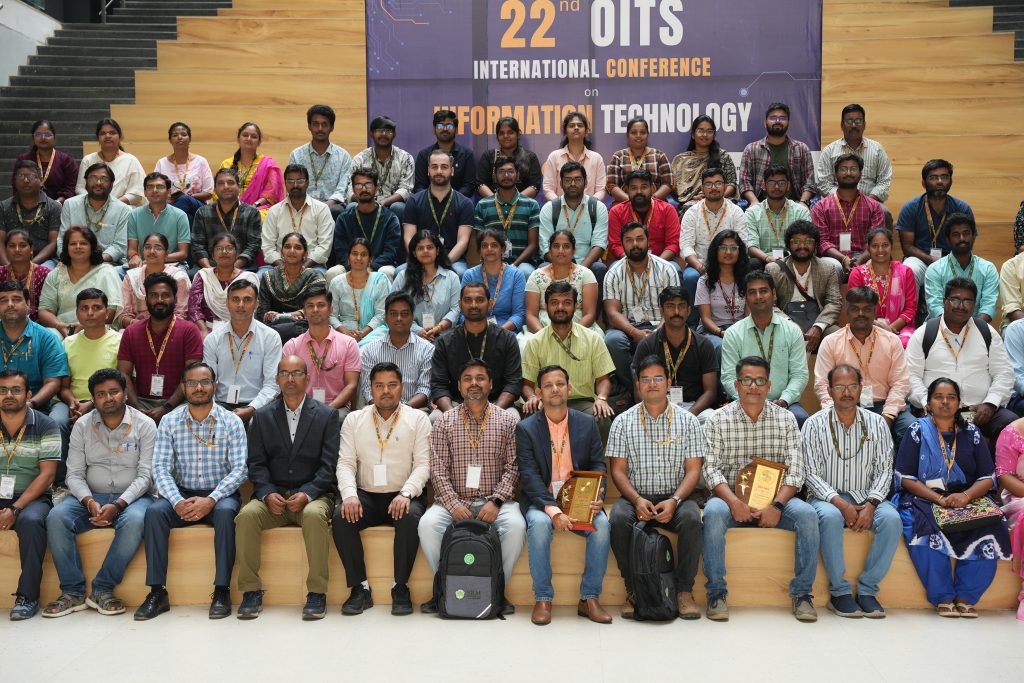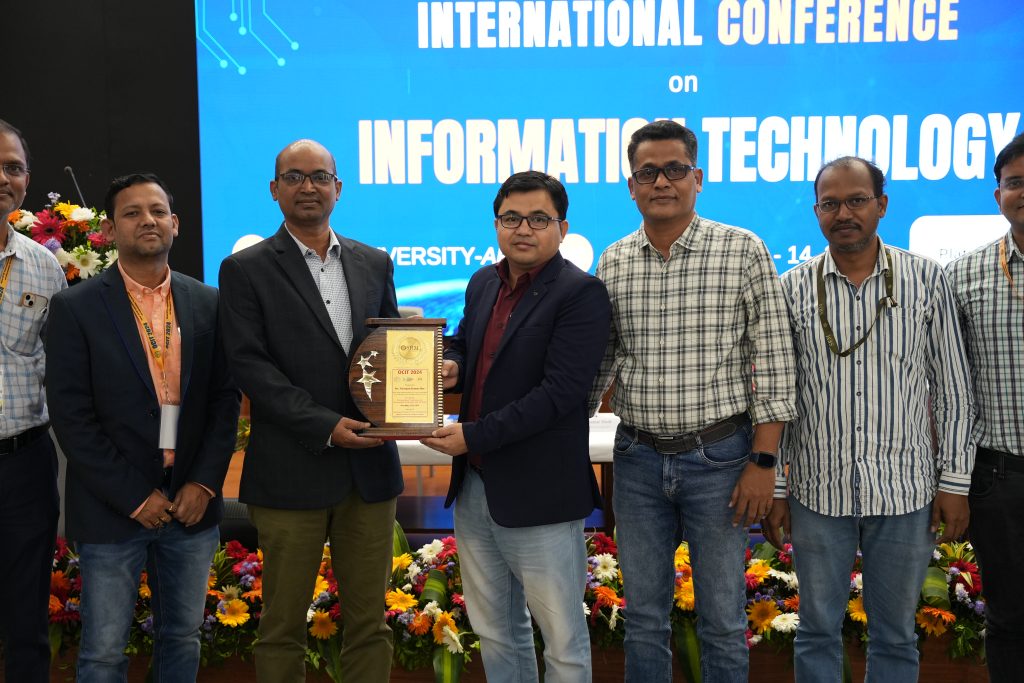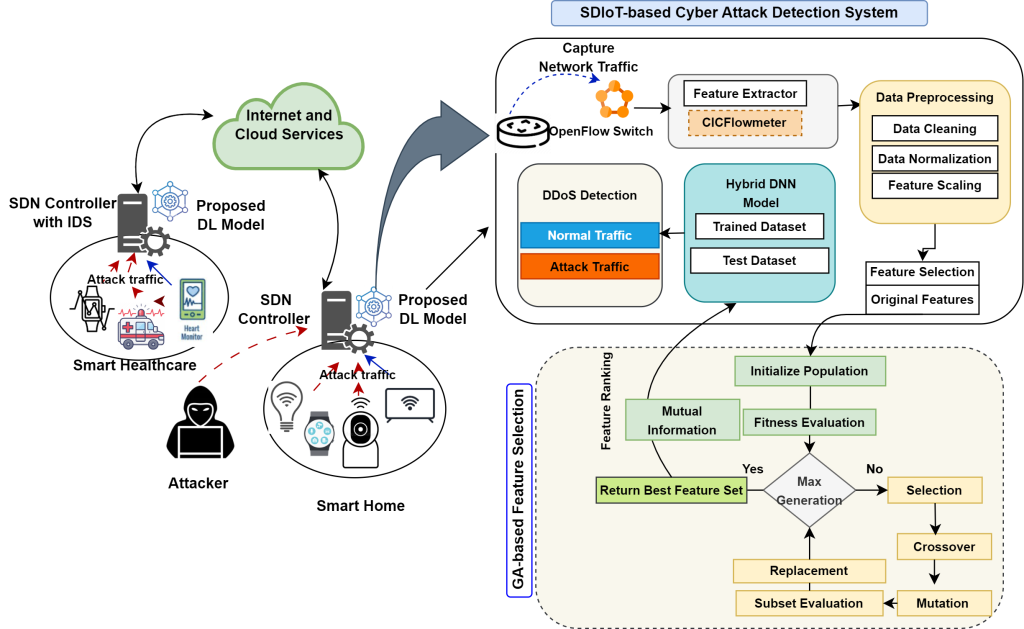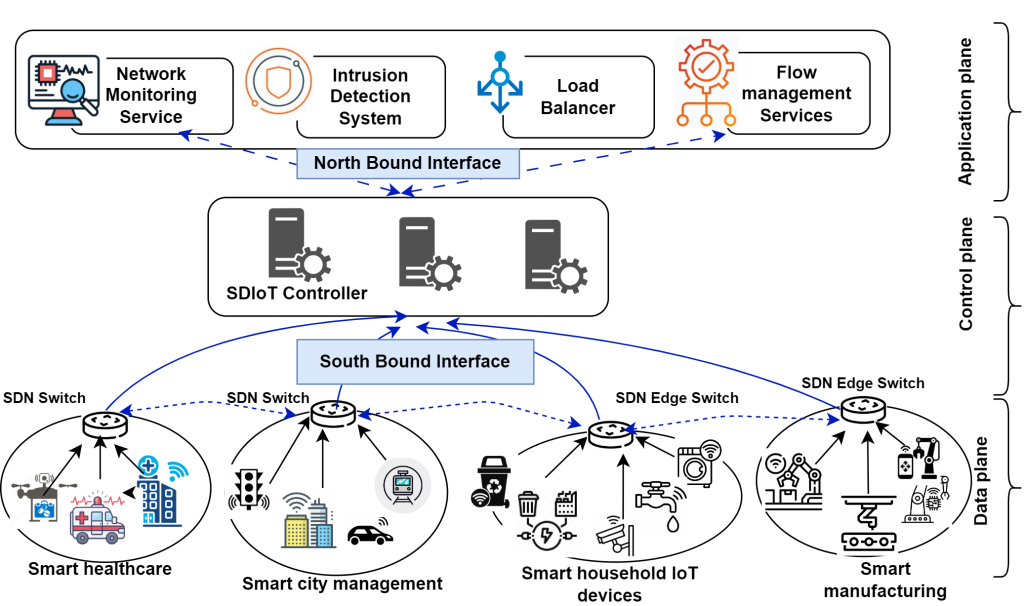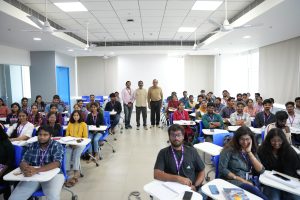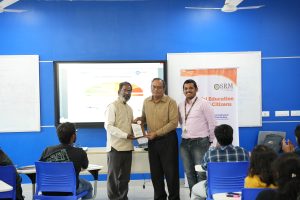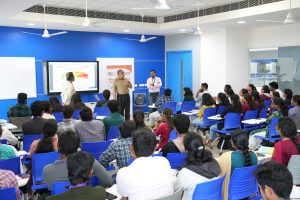SRM AP Partners with Uniglobus Electrical and Electronics Pvt. Ltd. for EC-less LED Lighting Research
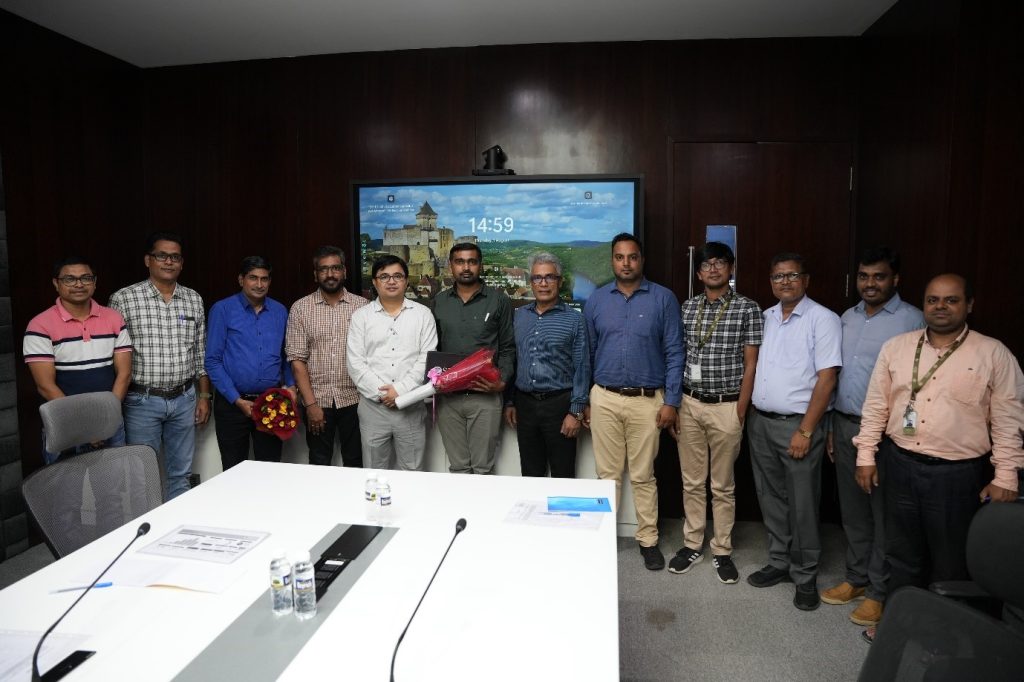
In a significant stride towards advancing sustainable energy technologies, SRM University-AP has signed an Memorandum of Understanding (MoU) with Uniglobus Electrical and Electronics Pvt. Ltd. The collaboration aims to develop cutting-edge EC-less LED lighting systems through a joint research initiative. The partnership was formalised following an exploratory visit by Uniglobus representatives, Mr Gajanan Inamdar and Mr Saurabh Maheta, to SRM AP. During their visit, they engaged in extensive discussions with the university faculty, identifying EC-less LED drivers as a promising area for impactful research.
Dr Ramanjaneya Reddy Udumula, Assistant Professor from the Department of Electrical and Electronics Engineering, will lead this innovative project as the Principal Investigator. Highlighting the significance of the collaboration, he noted, “This research initiative will address critical challenges in energy-efficient lighting while fostering a bridge between academic insights and industrial expertise.”
Uniglobus has also invited Dr Udumula to visit its state-of-the-art facilities to gain an in-depth understanding of their advanced product line. This visit underscores the mutual commitment to fostering a symbiotic relationship between academia and industry, paving the way for groundbreaking technological advancements.
Key figures instrumental in making this collaboration a reality include Vice Chancellor Prof. Manoj K. Arora, Prof. Ranjit Thapa, Dean of Research; Prof. Vinod Kumar G S, Associate Dean of the Technology Transfer Cell; and Prof. C.V. Tomy, Dean of the School of Engineering and Applied Sciences (SEAS). Their collective efforts, alongside the support of Mr BS Praveen from Uniglobus, have laid the foundation for this transformative partnership.
The project focuses on addressing critical global challenges associated with energy sustainability and efficiency. With the rapid industrial growth and increasing global population driving energy demand, the limitations of conventional energy sources have become a pressing concern. Governments and industry leaders worldwide are calling for innovative solutions to promote energy-saving and sustainable technologies.
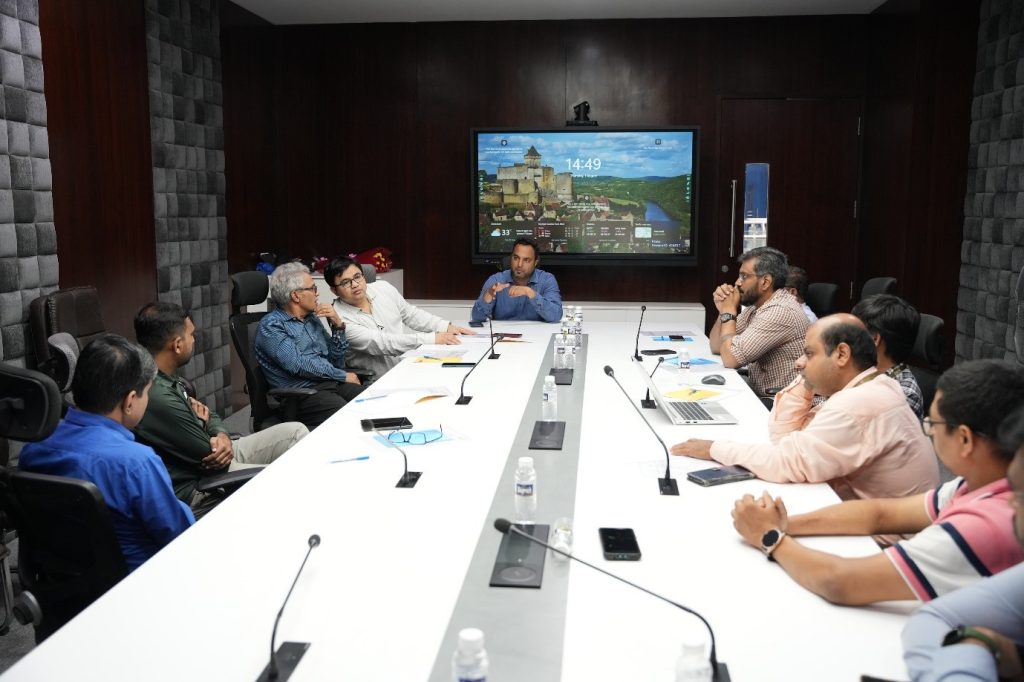
A Game-Changing Innovation
The research aims to develop an Electrolytic Capacitor (EC)-less, ripple-free LED driver system. Unlike conventional LED drivers, this system employs a DC-DC converter as a power factor correction (PFC) unit and a bi-directional buck-boost converter (BDC) to eliminate second harmonic ripples. This configuration simplifies control mechanisms while ensuring high power factor and reduced total harmonic distortion, delivering a steady DC current to the LED load.
Towards a Sustainable Future
This collaboration marks a significant milestone in addressing sustainability challenges through innovation. By merging the academic expertise of SRM University-AP with the industrial insights of Uniglobus Electrical and Electronics Pvt. Ltd., the partnership seeks to deliver impactful solutions for a greener, more sustainable future.
The MoU underscores SRM University-AP’s commitment to fostering innovation through strategic collaborations, positioning the institution at the forefront of research and technological development in energy efficiency. Both partners look forward to a fruitful and enduring collaboration that promises to benefit society at large.
- Published in Departmental News, EEE NEWS, MoU, News, Research News
The Key to a Transformative Future – Systems Engineering Summit 2025 at SRM AP
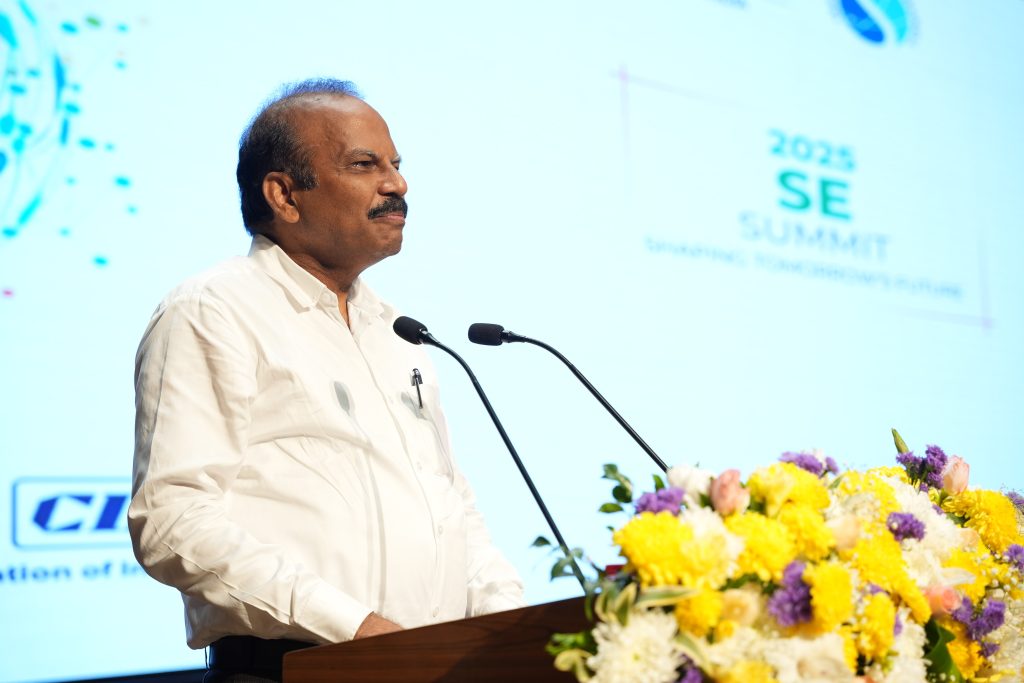
“The future is going to be a system of systems,” – Mr Dasari Ramakrishna, CEO & MD of Efftronics Systems Pvt. Ltd. at the Systems Engineering Summit 2025 hosted by SRM University-AP.
SRM University-AP kicked off the prestigious Systems Engineering Summit 2025 (SES 2025) on January 23, 2025, partnering with Efftronics Systems Pvt. Ltd., INCOSE India, IEEE Systems Council, Confederation of Indian Industry (CII) and the Information Technology Association of Andhra Pradesh (iTAAP). This two-day summit, to empower the next generation of system engineers, is designed as an outreach initiative to introduce students, faculty, and industry professionals to fundamental concepts, techniques, and exciting career thoughts in systems engineering.
Vice Chancellor, Prof. Manoj K Arora remarked, “Systems Engineering is a highly interdisciplinary field that overarches all branches of engineering and management disciplines. The SES 2025 is an informative platform for young engineers to understand how systems engineering drives innovation in today’s complex world.”
This summit brought together thought leaders and industry practitioners from different sectors, such as aerospace, automotive healthcare, defence, and industry manufacturers, for an array of keynote sessions and panel discussions on systems engineering as a key to navigating the transforming world. Mr Dasari Ramakrishna of Efftronics Systems Pvt Ltd opined that Systems Engineering provides exceptional aspirational directions and career thoughts. He said that in this rapidly evolving world, automation with a system of systems integration is the future, and it is time to introduce the concept into the curriculum of higher educational institutions.
An MoU was signed between SRM University-AP and Efftronics Systems Pvt. Ltd. to ensure active industry participation in academia, bridging the gap between the classroom and the workforce. SRM University-AP and the other participating universities, VIT-AP University, Vignan University, Siddhartha Academy of Higher Education, and Acharya Nagarjuna University, also signed an MoU with INCOSE India, exploring various opportunities to ensure the academic curriculum of the universities are made industry-ready.
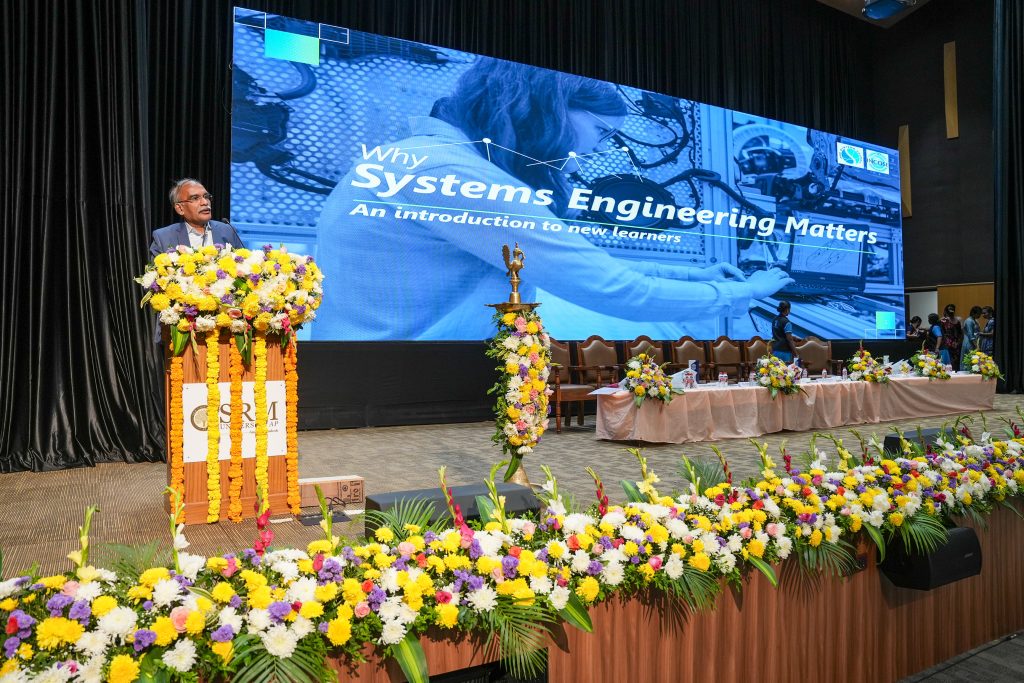
Dr Yogananda Jeppu, Executive Committee Member – Academia, INCOSE India, Technical Fellow and Systems Architect – Boeing, stated, “The collaboration between industries and educational universities is the driving force of innovation. In a world of interconnectedness and complexity, systems engineering is the interdisciplinary field that will break the silos and bring innovation through its methodology.”
Notable dignitaries from industry, academia and the government including Smt. Lakshmi Mukkavilli, President, IT Association of Andhra Pradesh, MD – Patra India BPO Services; Dr S V Kota Reddy, Vice Chancellor, VIT-AP University; Prof. Paruchuri Venkateswara Rao, Vice Chancellor, Siddhartha Academy of Higher Education; Prof. K Gangadhara Rao, Vice Chancellor, Acharya Nagarjuna University; Cmde. Dr M S Raghunathan, Registrar, Vignan University; Dr Maheswar Dwivedy, Associate Dean – Academia-Industry Relations and Professional Internships, SRM AP also shared their insights on the significance of this prestigious summit.
The Systems Engineering Summit 2025 organised as a joint initiative by SRM AP and various organisations, proved to be not just a summit but a call for action. The summit inspired a meaningful dialogue to create a roadmap for technological advancements in systems engineering for a more equitable and more sustainable society.
- Published in News, Research News, University Event
Renowned Nanoscientist Prof. Pulickel M Ajayan Delivered UDL#19
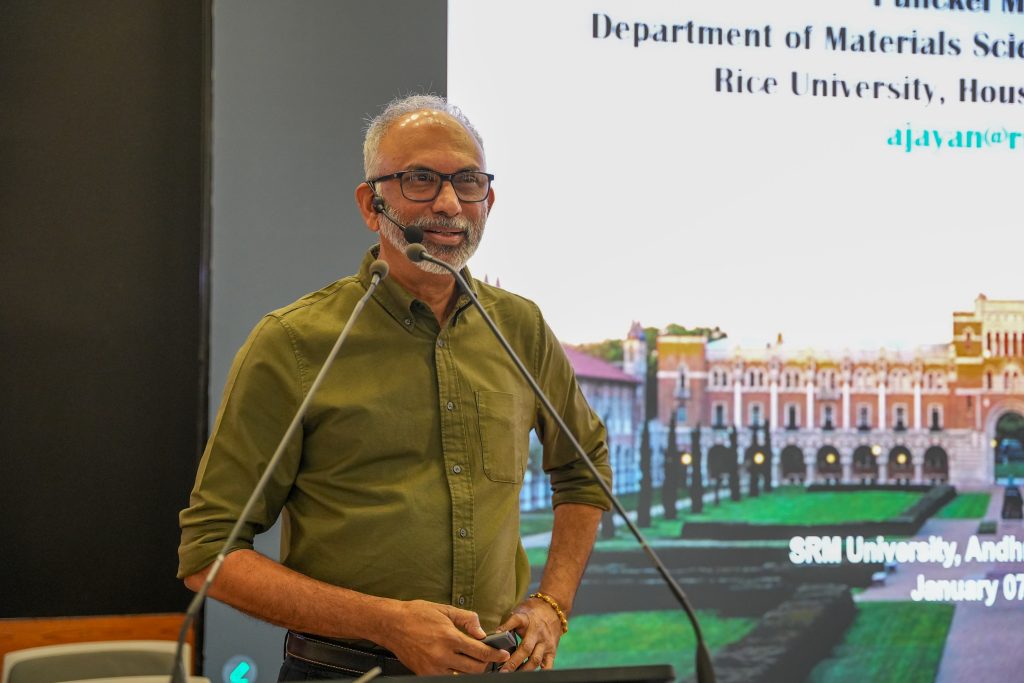
“Engineering very small things, structures less than 10nm, is challenging – and this is my biggest interest.” – Prof. Pulickel M Ajayan.
The university hosted its nineteenth edition of the University Distinguished Lecture, featuring a celebrated talk on “Nano-Engineered Materials” by eminent scientist Prof. Pulickel M Ajayan, Benjamin M. and Mary Greenwood Anderson Professor of Engineering and Founding Chair of the Department of Materials Science and Nanoengineering at Rice University, Texas, USA on January 07, 2025. A pioneer in nanotechnology with a noteworthy career extended to three decades, Prof. Ajayan’s session elucidated the recent developments in nanotechnology, particularly in relation to the challenges in designing and controllably synthesising functional nano-engineered materials.
Prof. Ajayan spoke extensively on the three major key points – Atomically Thin Layers (2D) Vertical and Lateral Heterostructures, Defects & Single Atoms and Printed 3D Nano-architectures & Nanocomposites. “Three decades ago, nanotechnology or nanomaterial science was just emerging. Today, it has become an enabling technology with fundamental developments in controlled manufacturing of nanomaterials,” remarked Prof. Ajayan in his lecture. He proceeded to elucidate the various phases of nanotechnology – the first phase, where scientists worked on the fundamental understanding of material synthesis, controlled fabrication, etc.; the second phase of integrating nanotechnology into potential devices; and the current phase of high-tier development through commercialisation.
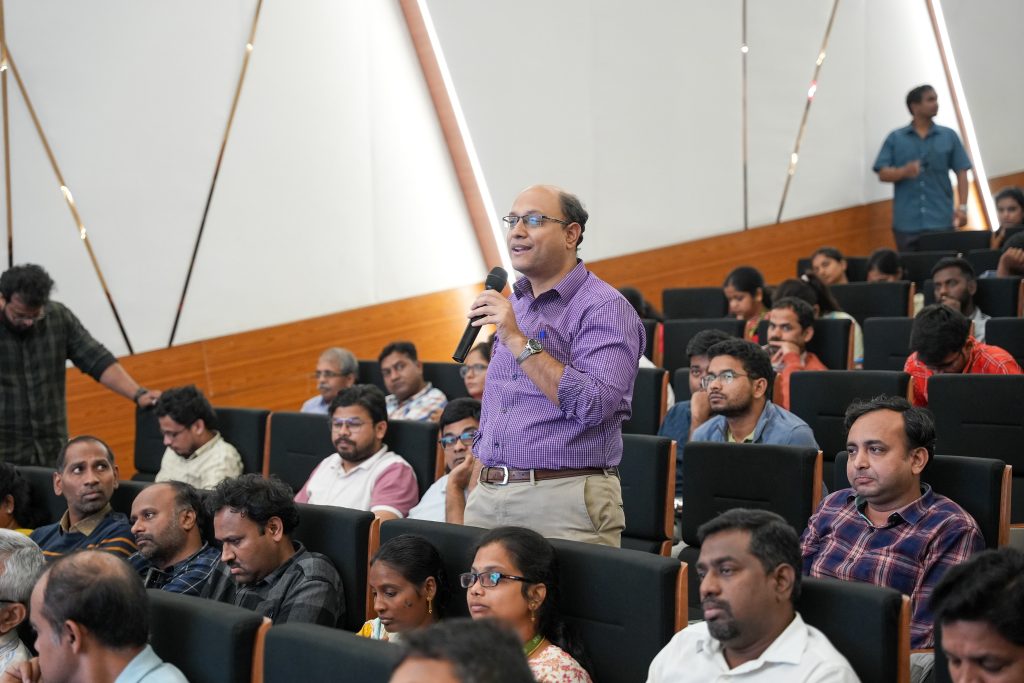
“A prominent figure in nanotechnology, Prof. Ajayan’s work in carbon nanotubes is exemplary in understanding the building of nano heterostructures. It is a privilege to have him share his wealth of knowledge on this remarkable occasion,” said Prof. CV Tomy, Dean – SEAS, in his welcome address. Prof. Ranjit Thapa, Dean – Research, also praised Prof. Ajayan for his contributions to nanoengineering and material science. Prof. Ajayan also had a brief interaction with the faculty regarding potential academic and research collaborations.
The 19th University’s distinguished lecture on nano-engineered materials ignited genuine curiosity about the field among the participating students. The profile of Prof. Pulickel M Ajayan and his astounding research portfolio motivated both faculty and students to explore nanoengineering and material sciences. The 19th UDL was graced by the presence of Registrar Dr R Premkumar, Deans of various schools, faculty from various streams and students of the varsity. The UDL series is a testament to the university’s passion for research and commitment to place SRM AP in the frontiers of academic and research excellence.
- Published in News, Research News, University Distinguished Lecture, University Event
2D Metallene Designs to Advance Multifunctional Electrocatalysis
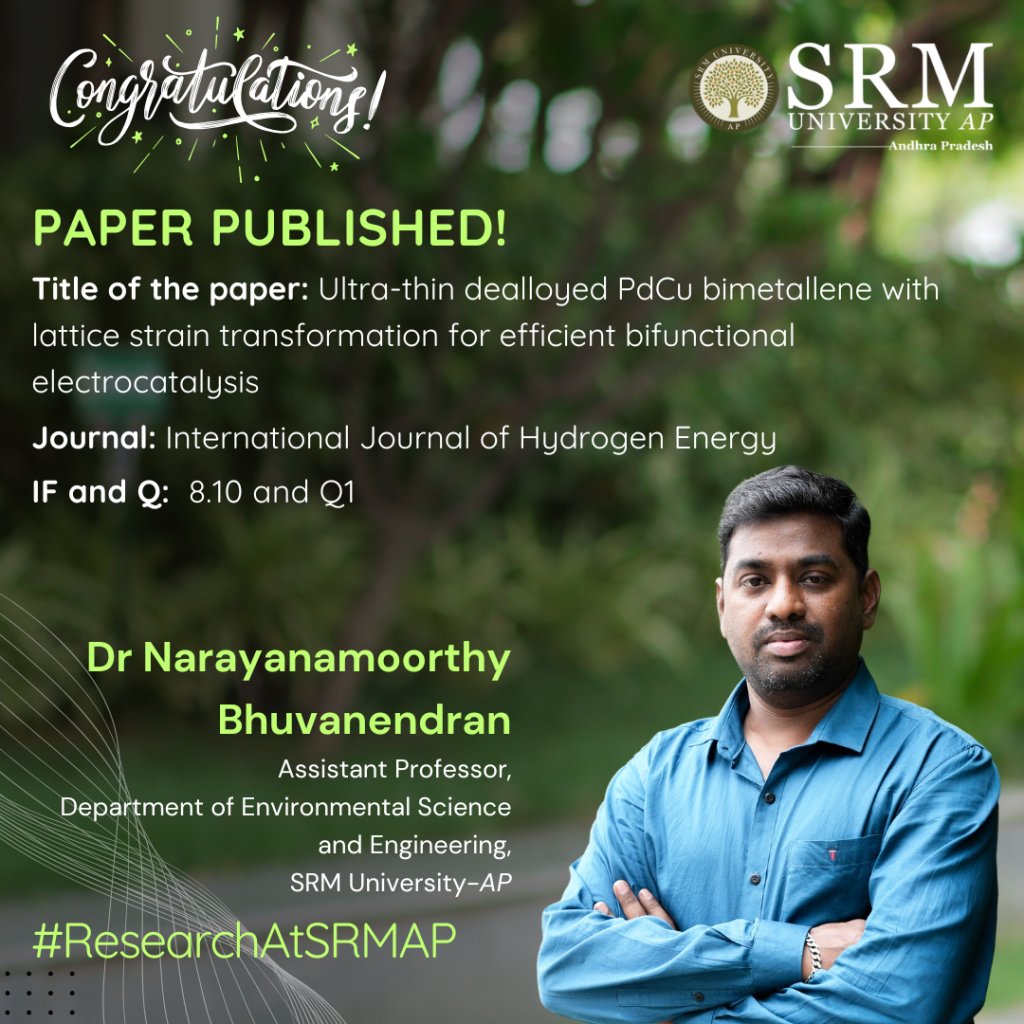
Dr Narayanamoorthy Bhuvanendran, Assistant Professor in the Department of Environmental Science and Engineering, has published his research work as an article titled “Ultra-thin Dealloyed PdCu Bimetallene with Lattice Strain Transformation for Efficient Bifunctional Electrocatalysis” in the esteemed International Journal of Hydrogen Energy, which has an impact factor of 8.10. His work underscores the development of 2D PdCu bimetallene with improved structural and electronic properties displaying super-catalytic behaviour.
Abstract
Two-dimensional (2D) PdCu bimetallene (PdCu) demonstrates exceptional structural and electronic properties, making it highly effective for electrochemical reactions in energy applications. Electrochemical dealloying (DA) of PdCu enhances surface reactivity by modulating electronic structure and inducing strain, optimising its performance for oxygen reduction (ORR) and methanol oxidation (MOR) in alkaline media. DA PdCu features a heterogeneous surface with abundant defects, improving active site availability and reaction kinetics. It achieves superior ORR mass activity (0.62 mA µg⁻¹) with a 10 mV positive half-wave potential shift after 20,000 cycles and MOR mass activity (3335.9 mA mg⁻¹) with 62.3% retention after 10,000 cycles. Theoretical studies reveal the impact of strain-induced electronic modulation on intermediate adsorption energies, corroborating experimental findings. This alloying-dealloying strategy in 2D PdCu bimetallene offers a robust approach to advancing multifunctional electrocatalysis with enhanced durability and performance.
Explanation of the Research in Layperson’s Terms
This research highlights the development of a two-dimensional PdCu bimetallene catalyst with tailored structural and electronic features, offering transformative advancements for electrochemical energy conversion and storage systems. The unique properties of 2D metallene layers, including their high surface area, tunable electronic structure, and enhanced surface reactivity, play a pivotal role in optimising catalytic performance. By employing a controlled dealloying process, the atomic and electronic structure of PdCu bimetallene is significantly modified, introducing lattice distortions, abundant surface defects, and a heterogeneous crystalline-amorphous interface. These features create more active sites and improve the interaction with reaction intermediates, leading to superior catalytic behaviour. The material demonstrates outstanding efficiency in oxygen reduction (ORR) and methanol oxidation (MOR), critical reactions in fuel cells and other electrochemical energy systems. For ORR, the catalyst achieves high mass activity, long-term stability, and resistance to degradation, maintaining its performance after extensive testing. In MOR, the catalyst exhibits exceptional activity and durability, retaining a significant portion of its efficiency over prolonged cycles. These structural and functional attributes emphasize the importance of 2D metallene designs and the alloying-dealloying strategy in enhancing the structure-activity relationship, establishing a foundation for innovative electrocatalysts in sustainable energy technologies.
Practical Implementation/ Social Implications of the Research
This research offers a practical pathway to revolutionise renewable energy systems by advancing next-generation electrocatalysts for fuel cells, metal-air batteries, and other energy conversion technologies. The optimised two-dimensional PdCu bimetallene, with enhanced ORR and MOR performance, demonstrates significant potential for clean energy applications such as proton-exchange membrane fuel cells and direct methanol fuel cells, addressing critical needs for efficiency and durability. The scalable, environmentally friendly alloying-dealloying synthesis reduces reliance on expensive platinum, lowering production costs while delivering high catalytic performance. By enabling efficient energy storage and conversion, supporting carbon-neutral systems, and inspiring the design of versatile 2D metallenes for diverse applications, this research significantly contributes to sustainable energy transitions and global climate goals.
Collaborations
- Prof. Sae Youn Lee, Department of Energy and Materials Engineering, Dongguk University, Seoul, Republic of Korea.
- Dr Wan-Gil Jung, Korea Basic Science Institute, Gwangju Center, Republic of Korea.
- Prof. Ming-Chang Lin, Department of Applied Chemistry, National Yang-Ming Chiao Tung University, Hsinchu, Taiwan.
- Dr Venkatesan Srinivasadesikan, Department of Chemistry, School of Science and Humanities, Vignan’s Foundation for Science, Technology and Research, Guntur, Andhra Pradesh, India.
Future Research Plan
Future research will focus on designing nanostructured hybrid electrocatalysts with enhanced activity, stability, and selectivity for energy and environmental applications. Emphasis will be placed on tailoring nanoscale architectures and synergistic material interactions to optimize performance in processes such as water splitting, CO2 reduction, NO3 reduction, fuel cells, and pollutant degradation, enabling scalable and sustainable solutions to global challenges.
- Published in Departmental News, ENVS News, News, Research News
Commemorating National Mathematics Day
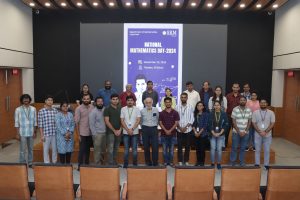 The Department of Mathematics commemorated National Mathematics Day on December 20, 2024, with a remarkable event honouring the birth anniversary of the legendary mathematician Srinivasa Ramanujan. The celebrations encapsulated Ramanujan’s works, achievements, and the significance of mathematics in everyday life through various guest talks, programmes, and a movie screening.
The Department of Mathematics commemorated National Mathematics Day on December 20, 2024, with a remarkable event honouring the birth anniversary of the legendary mathematician Srinivasa Ramanujan. The celebrations encapsulated Ramanujan’s works, achievements, and the significance of mathematics in everyday life through various guest talks, programmes, and a movie screening.
Chief guest Prof. Rajat Tandon, Retired Professor from Hyderabad Central University, delivered the keynote session underscoring the significance of the subject and recognising its widespread applications in technology, engineering, economics, healthcare, and beyond. Dr Sazzad Ali Biswas, Assistant Professor from the Department of Mathematics, SRM AP, also elucidated exploring the world of mathematics and the myriad of opportunities that lie within academia, industry, and research.
The National Mathematics Day Celebrations also featured a movie screening of the Oscar-winning film A Beautiful Mind, a biographical drama about the mathematician John Nash, a Nobel Laureate in Economics. The film engaged students in a deep exploration of mathematics and inspired them to achieve excellence in the field.
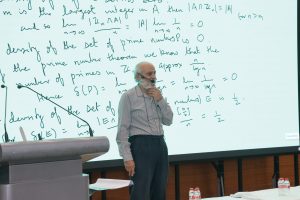
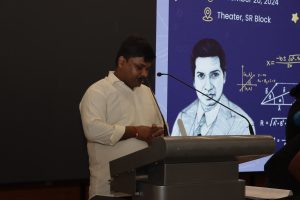
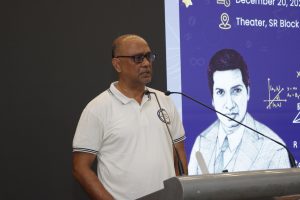
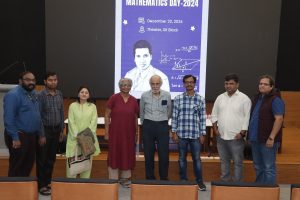
- Published in Departmental News, Math News, News
OCIT-2024: An International Conference Exploring Trends in Information Technology
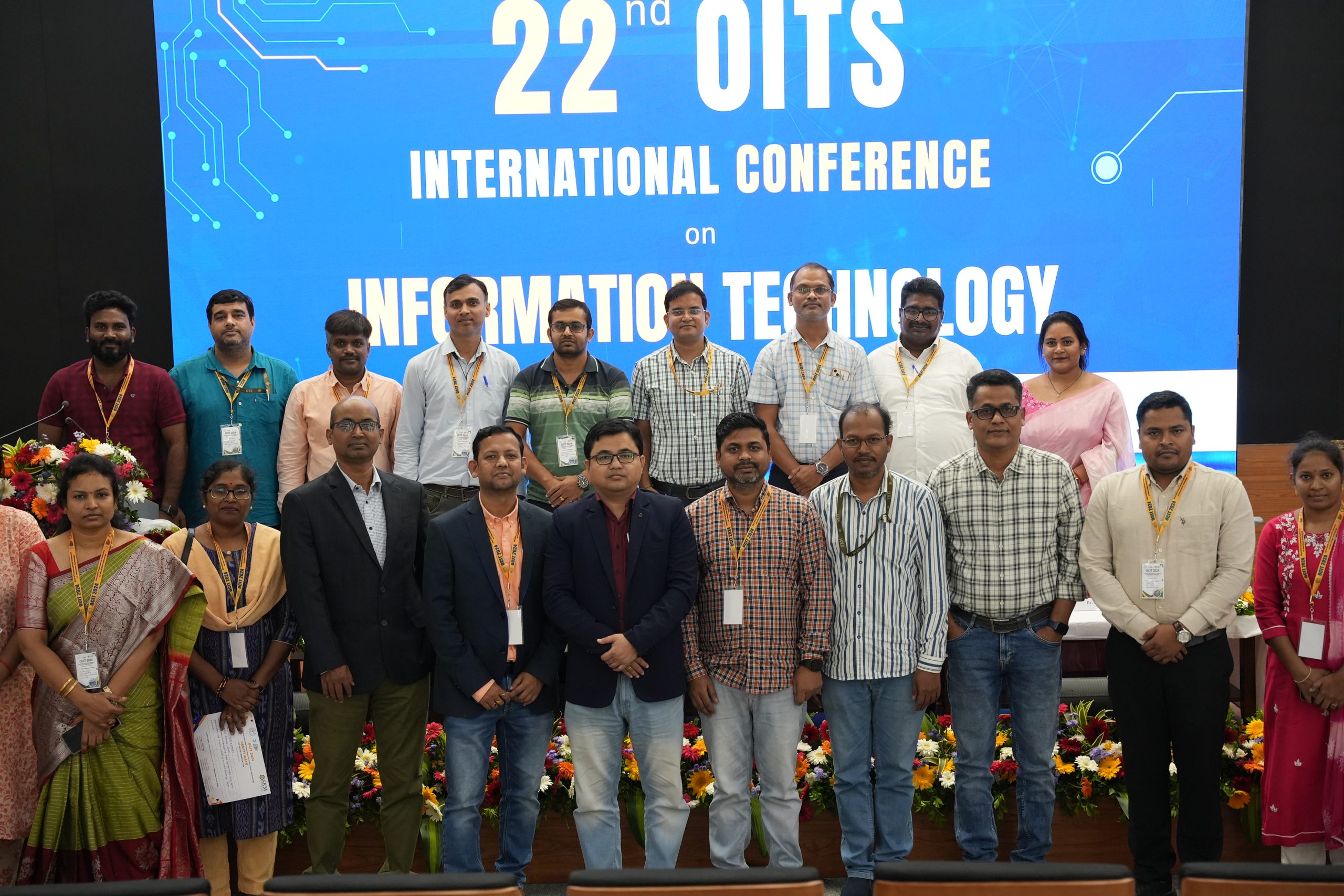
The 22nd OITS International Conference on Information Technology (OCIT-2024) was hosted at SRM University-AP from December 12 to 14, 2024. The conference, which served as a premier platform to discuss advancements in information technology, brought together distinguished academics, researchers, industry professionals, and students from across the globe. OCIT-2024 witnessed a submission of 600 research papers, out of which 136 papers were accepted and registered for presentation after rigorous review.
OCIT 2024 had seven keynote speakers who delivered insightful presentations, offering deep expertise and futuristic perspectives on emerging trends: Prof. Arun Kumar Pujari, HOD of AI & CSE, Adviser & Professor Emeritus Mahindra University, Prof. Banshidhar Majhi, Professor (HAG), Comp Sc.& Engg. NIT Rourkela, Former Director, IIITDM KP, Former VC, VSSUT Burla, Prof. Prabir Kumar Biswas, IIT Kharagpur, Prof. Sharad Sharma (University of North Texas UNT), Dr Kannan Srinathan (IIIT Hyderabad), Prof. Siba Kumar Udgata (University of Hyderabad), Dr Kumar Goutam (Founder & President of QRACE).
Esteemed session chairs guided thought-provoking discussions, elevating the intellectual rigour of the conference. Presenters also shared cutting-edge research, fostering a vibrant exchange of ideas and innovation. The topics explored ranged from artificial intelligence and machine learning to advanced networking and quantum computing. The conference emphasised the importance of collaboration between academia and industry in addressing global challenges and shaping the future.
The conference concluded on a high note, inspiring participants to continue their pursuit of excellence in research and innovation. 12 papers were recognised as the best papers for their exceptional quality and contribution. All 136 accepted papers will be published in IEEE Xplore (Scopus Indexed). Additionally, approximately 15% of the papers will receive extended invitations for submission to peer-reviewed journals.
OCIT-2024 was a remarkable event, leaving a lasting impact on its participants and setting the stage for future technological advancements. The event celebrated the spirit of innovation and research through well-curated presentations.
- Published in CSE NEWS, Departmental News, News, Research Events, Research News
Where Technology Meets Literature: Reviving Sindhi Libraries with a Digitised Five-point Framework
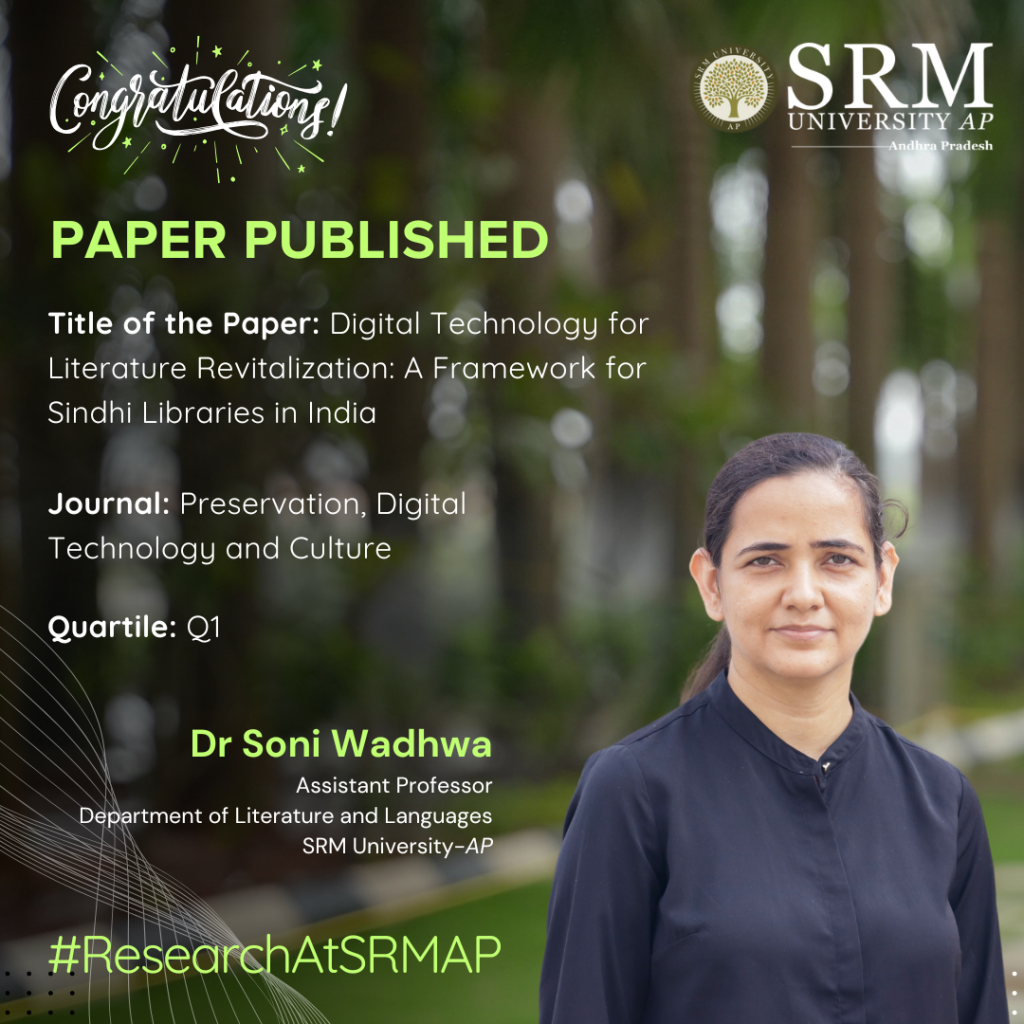
Minor languages face many challenges in India and elsewhere. With most of these languages on the verge of extinction, preservation efforts using technology need to develop a different vision for helping these languages and their communities. Dr Soni Wadhwa, Assistant Professor from the Department of Literature and Languages, has published her research in the article “Digital Technology for Literature Revitalisation: A Framework for Sindhi Libraries in India” in the Q1 journal Preservation, Digital Technology and Culture, highlighting on overcoming these challenges. Her research emphasises a five-point framework to revive Sindhi literature.
Abstract
Linguistic diversity does not find adequate space in LIS discourses around libraries in India and other regions with similar kinds of linguistic heritage. This study focuses on the state of Sindhi literature in India through a look at the libraries that house the works of Sindhi literary activity in post-Partition India. The objective is to highlight the role of libraries within language revitalization efforts. This study puts forth a five-point framework for digital transformation of Sindhi libraries in India which can help broaden the digital transformation efforts elsewhere in the Global South especially with minor languages and dialects. While the five-point framework is customized to the specific challenges faced by Sindhi regarding its script (and includes designing solutions for OCR, transliteration, and text to speech interaction), its principles could be applied to several other linguistic contexts, especially in the Global South. It, thus, seeks to bring LIS into sharp focus within the social imagination of communities of readers and as speakers of a language, and not just as academic institutions alone.
Practical Implementation/Social Implications of the Research
- Using this five-point framework, scholars from various fields (history, partition studies, language, literature, digital humanities, digital archiving, etc) can identify different ways of preserving the Sindhi language.
- The use of technology for this purpose can lead to technological innovation, which in turn can accelerate preservation efforts.
- Similar models and frameworks can be developed for other minor languages.
Collaboration
The project is funded by IIT Indore.
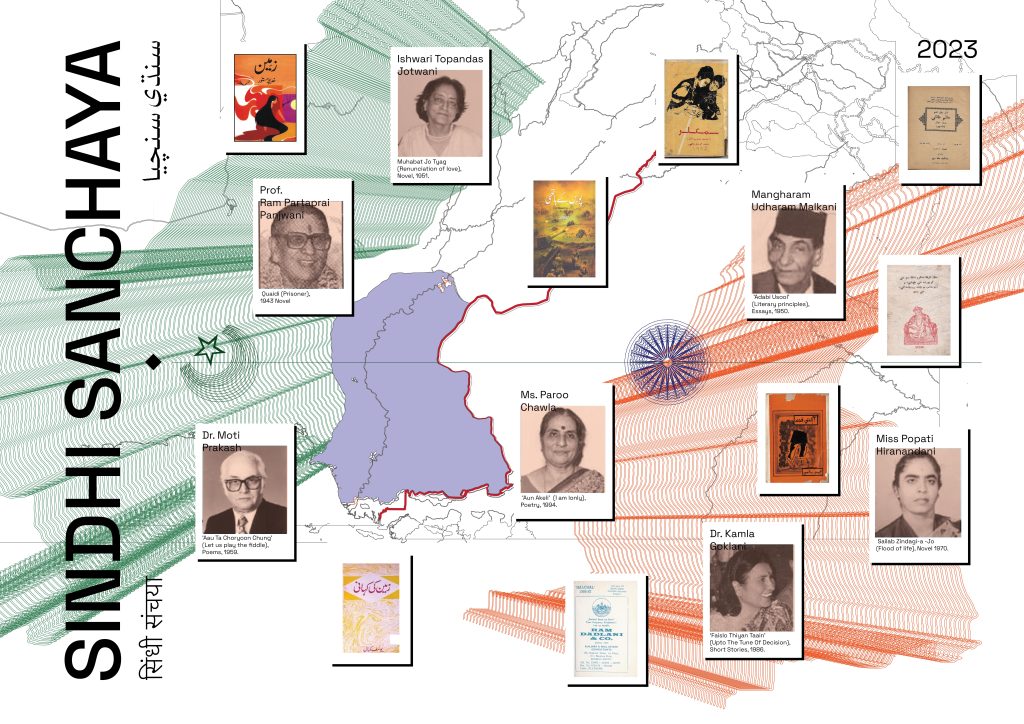
- Published in Departmental News, English Current Happenings, English news, News, Research News
A Unified Learning Framework for Detecting Cyberattacks in IoT Networks
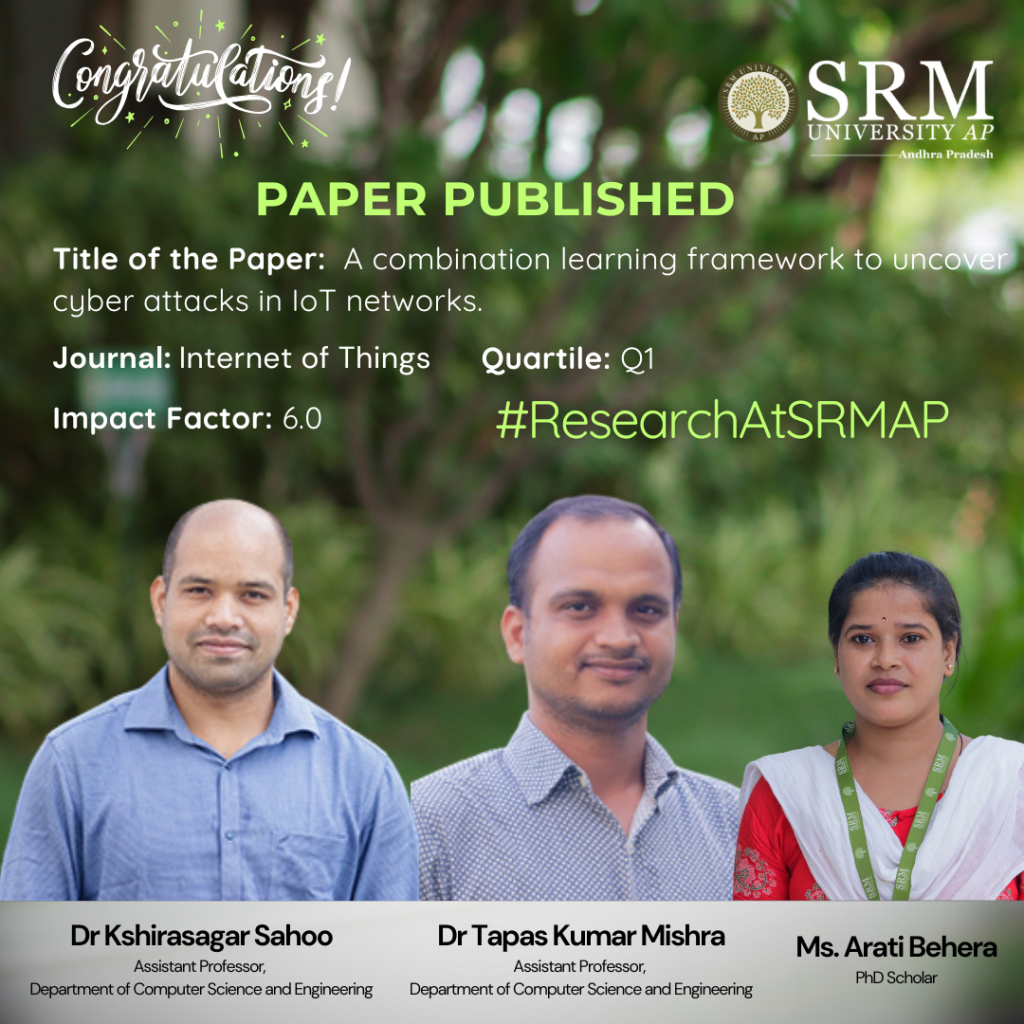
The Department of Computer Science and Engineering is proud to announce that Assistant Professors Dr Kshira Sagar Sahoo and Dr Tapas Kumar Mishra, along with their research scholar Ms Arati Behera, have published their paper “A Combination Learning Framework to Uncover Cyberattacks in IoT Networks” in the prestigious Q1 journal Internet of Things, which has an Impact factor of 6.
The article addresses IoT security challenges by utilising Software Defined Networking technology and AI. The authors use Genetic Algorithm to select the most important data features and a hybrid deep learning model combining CNN, Bi-GRU, and Bi-LSTM to detect cyber-attacks effectively. Tested on real-world IoT datasets, the system demonstrates superior accuracy, faster detection, and lower resource usage than existing methods, making it a promising solution for securing resource-constrained IoT networks.
Abstract
This study addresses the security challenges in IoT networks, focusing on resource constraints and vulnerabilities to cyber-attacks. Utilising Software Defined Networking and its adaptability, the authors propose an efficient security framework using a Genetic Algorithm for feature selection and Mutual Information (MI) for feature ranking. A hybrid Deep Neural Network (DNN) combining CNN, Bi-GRU, and Bi-LSTM is developed to detect attacks. Evaluated on InSDN, UNSW-NB15, and CICIoT 2023 datasets, the model outperforms existing methods in accuracy, detection time, MCC, and resource efficiency, demonstrating its potential as a scalable and effective solution for IoT network security.
Practical Implementation/ Social Implications of the Research
The practical implementation of this research lies in enhancing the security of IoT networks, which are increasingly integral to smart homes, healthcare, transportation, and industrial systems. By detecting and mitigating cyber-attacks efficiently, the proposed model can safeguard sensitive data, prevent service disruptions, and ensure the reliability of IoT systems.
Collaborations
This research has been conducted in partnership with Umea University Sweden.
Future Research Plans
There is potential to enhance the Deep Learning approach further to reduce the execution time at the power crunch device. Additionally, federated learning could be investigated as a use case, especially concerning edge devices within typical software-defined IoT networks.
- Published in CSE NEWS, Departmental News, News, Research News
Developing a High Gain Bi-directional Converter to Improve Efficacy in EV Applications
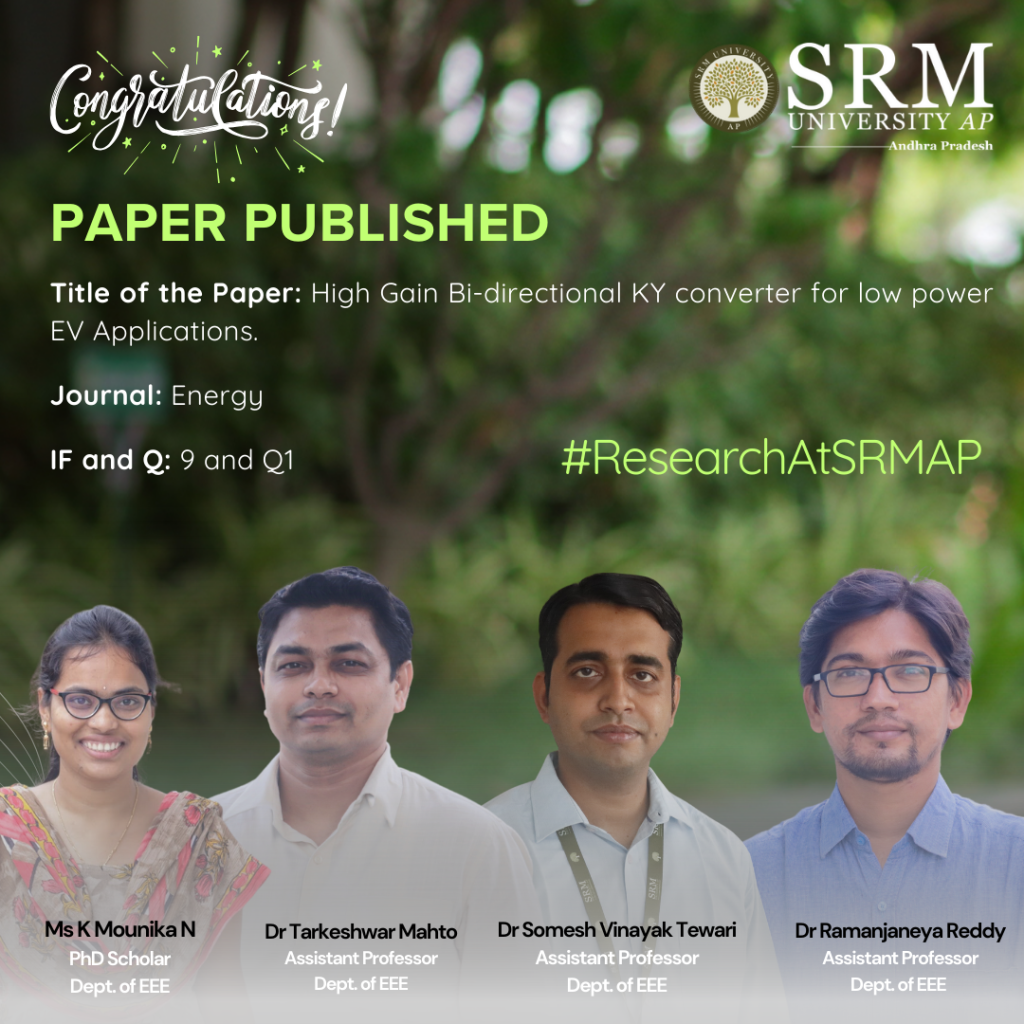
Electronic Vehicles (EVs) are a key element of carbon emission reduction strategies and pivotal to contributing to sustainable development. Operating solely on electrical energy, eliminating the need for petrol or diesel, EVs leave a significantly reduced carbon footprint compared to fossil fuel-powered vehicles. Underscoring the impact of EVs on the environment, advanced research is conducted to improve the efficacy and reliability of EVs.
On this note, a research team from the Department of Electrical and Electronics Engineering – Dr Tarkeshwar Mahto, Dr Somesh Vinayak Tewari, Dr Ramanjaneya Reddy and PhD scholar Ms K Mounika Nagabushanam has published a paper titled “High Gain Bi-directional KY converter for low power EV Applications” in the Q1 journal Energy having an Impact Factor of 9. Their research work focuses on the development of a bi-directional DC-DC converter that can be used in EVs for integration of battery to traction motor.
Abstract
In electric vehicles (EVs), the type of electric motor and converter technology have a significant impact on regulating the operational characteristics of the vehicle. Therefore, in this work, the modified bi-directional KY converter (BKYC) is proposed for EV applications. The main contributions of the proposed converter are high step-up/step-down conversion gain, bi-directional power flow, simplified control structure, continuous current, common ground, low volume, and high efficiency. An inductor on either side of the converter ensures continuous current flow and passive components are arranged to operate in series to offer high step-up/step-down conversion. The charging and discharging operations, steady-state analysis, and design process of the proposed converter are discussed in detail and compared with similar bi-directional converter topologies. Further, the efficiency analysis of the proposed converter is presented, and it was found that the efficacy is 95.51% in the charging operation and 96.52% in the discharging operation. The simulations are carried out using MATLAB/Simulink environment. Further, a prototype of a modified bi-directional KY converter is implemented with a TMS320F28335 processor and validated with theoretical and simulation counterparts.
Explanation of the Research in Layperson’s Terms
Electric vehicles (EVs) are built with traction motors, charging circuits, energy storage devices, and lighting systems. Each runs at a different voltage and has a different power level. Various power electronic converters are used to integrate the individual components of an electric vehicle. An electric vehicle (EV) runs primarily on battery power, which can be obtained from on-board charging or charging stations. The battery has a voltage range of 24 to 48 volts. The traction motor, coupled to a DC link bus with a voltage range of 400V to 600V, needs to receive this energy. Consequently, it is necessary to integrate a power converter to raise the voltage from lower voltage batteries to a higher voltage DC link. Additionally, energy lost during motor running can be used to charge batteries to improve the efficiency of the electric vehicle. Therefore, a separate power electronic converter is required for the power flow from the motor to the battery. The primary output of our study is the development of a bi-directional DC-DC converter that facilitates power flow from the battery to the motor and motor to the battery with the necessary voltage gains while maintaining improved efficiency and low cost.
The main challenges in EV technology are battery deterioration due to frequent charging and discharging and the volume of the power converter. The research team plans –
- To work on the noise reduction methods that are brought on by regeneration action
- To work on various control techniques to keep the DC link voltage of the propulsion system constant
- Published in Departmental News, EEE NEWS, News, Research News
Promoting Financial Literacy with NISM
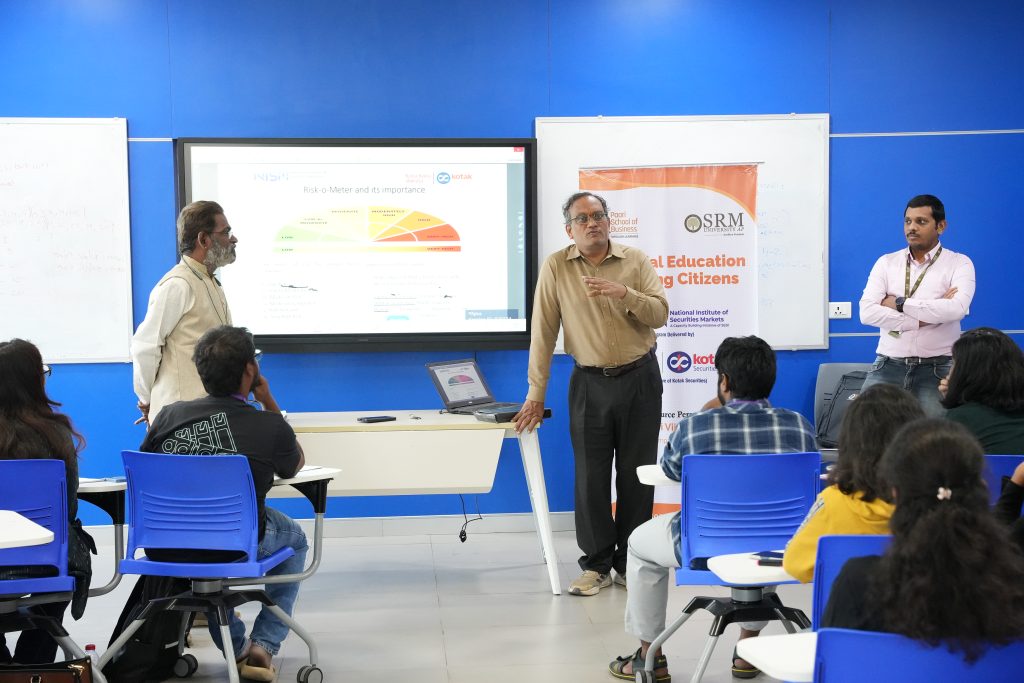
In a major initiative to promote financial literacy, the Paari School of Business organised a full-fledged Financial Education Programme under the Kona Kona Shiksha CSR Project, conducted by the National Institute of Securities Markets (NISM), on November 23 – 24 and 27 – 28, 2024. Mr Chilkuri Vijay Kumar, an NISM-empanelled resource person, conducted the programme, which saw enthusiastic participation from more than 140 MBA students.
The 10-hour programme covered, among the most important themes, career opportunities within the securities market, some investment fundamentals, primary and secondary markets, mutual funds, and various investor protection mechanisms. Besides lectures, dynamic discussions were conducted with insight into current happenings to introduce participants to the world of financial planning and investment strategies.
Mr Vijay Kumar’s interactive sessions helped students gain deeper insights into the securities market and clarified their understanding of the risks and opportunities of investment. Distributing e-certificates and comprehensive reading materials added value to the learning experience.
The session has set the stage for creating financially informed and responsible citizens. This has further reinforced Paari School of Business’s commitment to providing industry-relevant education and helping its students achieve professional excellence.
- Published in Departmental News, News, Paari Current Happenings, paari-events


